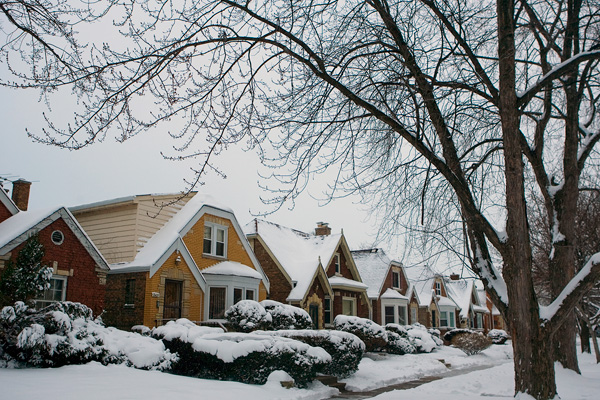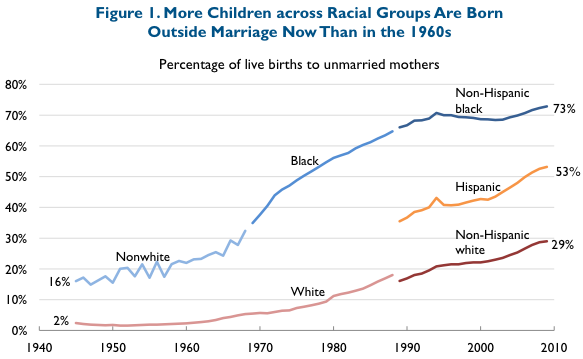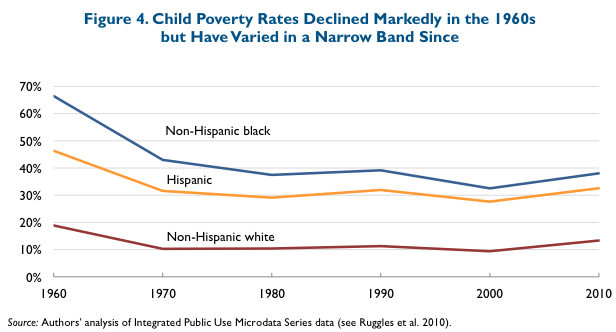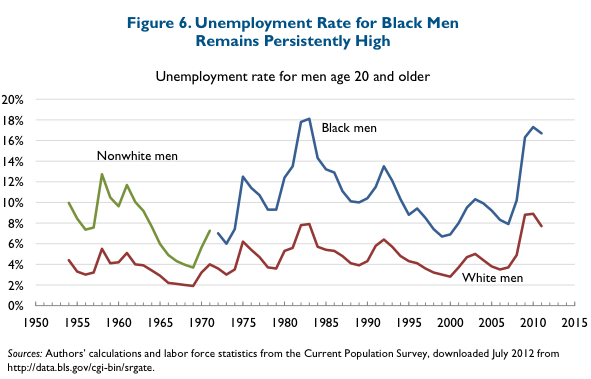
Photo: Tom Van Dyke/Chicago Tribune
85h Street and South Calumet, Chatham
This morning I woke up to the news that the 1965 Moynihan Report—officially known as The Negro Family: The Case for National Actions, meant to be an internal Johnson Administration report but leaked to the press—had been revisited by the Urban Institute. The original remains one of the most influential and controversial works on race and urban studies in American history, for this reason:
The letters provide extensive detail on the fallout over the “Moynihan Report,” which was the most searing experience of his professional life. Entitled “The Negro Family,” and prepared for Johnson in 1965, it identified the breakdown in the black family as the key cause of that group’s urban poverty, perpetuating a vicious cycle of broken homes, unemployment, and welfare dependency. Moynihan sought to use the paradigm of the family to enlist conservative support for a bold plan of affirmative action, which would bring African Americans not just liberty, but equality. The report itself, however, was long on description and short on action steps, lending it the appearance of a pointed finger.
Moynihan's work was more nuanced than that description suggests, as James T. Patterson (Freedom Is Not Enough: The Moynihan Report and America's Struggle Over Black Family Life from LBJ to Obama) has noted, and despite the backlash it's remained a foundational text. So the UI revisiting it makes plenty of sense, especially on the heels of Barack Obama's speech about black history at Bowie State.
The UI's report is brief; the news is not so good, and it's not so good in interesting ways. Some of the conditions Moynihan noted have gotten worse, but in similar ways across races:

And in some ways they've really improved, and again in similar ways across races:

And because three is a trend:

The trends have changed over time, in lockstep, but what's persistent has been the gap. It's depressing because so much of the work of the Civil Rights era was meant to close these economic gaps, and even in cases where economic conditions have improved generally, the divide remains similarly large over time.
Only in one instance, in the report, has the gap been closed: high school completion rates. In 1965, the completion rate for whites was around 70 percent, and for blacks around 45 percent. In 2010, it's close to 90 percent for both races, but a gap remains in college completion (a mystery I've written about before). That pattern is echoed in Chicago, as Steve Bogira writes in his Reader cover story on segregation in Chicago Public Schools:
High school graduation rates improved dramatically over the two decades, but the vast majority of CPS students were still at academic achievement levels far below what was needed to be ready for college. Moreover, racial gaps in achievement steadily increased. White students made more progress than Latino students; African-American students fell further behind all other groups. White, Asian, and Latino students improved modestly in reading, but there were "virtually no improvements" among African-American students, at the elementary or high school levels.
The revisited Moynihan report, like the original, focuses on family dynamics, and news reports have framed it that way as well; Patterson wrote his book because it continues to crop up over and over again in discussions about poverty and violence. In The Atlantic, Ta-Nehisi Coates brought this up in "How the Obama Administration Talks to Black America," a reaction to the president's Bowie State speech, in which Obama said that "today, instead of walking miles every day to school, they're sitting on couches for hours playing video games, watching TV. Instead of dreaming of being a teacher or a lawyer or a business leader, they're fantasizing about being a baller or a rapper."
Coates writes: "When I was kid I wanted to be Tony Dorsett — or Rakim, whichever came first. Perhaps there is some corner of the world where white kids desire to be Timothy Geithner instead of Tom Brady. But I doubt it." Which, right. I wanted to be John Stockton or Ozzie Smith. (That dream died, but I'd still trade my job for Jed Hoyer's.) He continues: "What is specific to black kids is that their dreams often don't extend past entertainment and athletics. That is a direct result of the kind of limited cultural exposure you find in impoverished, segregated neighborhoods. Those neighborhoods are the direst [ed. note: direct? either way] result of American policy."
The part about neighborhoods struck me, because I'm reading a new U. of C. press book that's pretty much about the same thing as the revisited Moynihan report: Stuck in Place: Urban Neighborhoods and the End of Progress Toward Racial Equality, by NYU sociologist Patrick Sharkey. He starts his analysis in the late 1960s because 1) that's when a lot of the concrete legal gains of the Civil Rights movement had been made, and 2) a lot of the useful data we have begins then, too. The Moynihan report comes up in the first paragraph (as does the Kerner Commission). And Sharkey's broadest conclusion is similar:
If one had assumed in 1968 that freedom from legalized discrimination was the crucial step in the path towards racial equality, then one might have also assumed that the children who were raised in this period should have benefitted most from the expansion of civil rights in the 1960s. Yet this is a generation of African American children who have made virtually no economic progress relative to their parents.
But Sharkey focuses more on the effect of neighborhoods over generations, as Coates wishes the Obama administration would do (how much the Obama administration has done is the matter of some controversy). And there are interesting reasons for that:
Racial gaps in education and occupational status can be explained by pointing backward in time, and analyzing the types of family environments in which children were raised. If one were to compare a black and a white child raised in similar families and in similar neighborhoods, one would find, on average that the two children end up with roughly equivalent types of jobs as adults, and the black child would end up with more education.
That last bit is interesting. It's not a lot more; what Sharkey calls the "reverse racial gap" amounts to 0.55 years of schooling. Above I noted that the one gap that really has been closed is high-school graduation rates, which essentially doubled for blacks over 40 years to reach near-equality.
Elsewhere Sharkey shows that blacks are much more likely to have more schooling than their parents (55 percent to 38 percent), and less likely to have less education (21/33); blacks and whites are equally likely to be in a higher education category than their parents (48/47), and whites are more likely to be in a lower education category (19/26). But that only goes so far:
A very different pattern emerges when we consider racial inequality in employment and economic status, as measured by both income and wealth. For these outcomes, aspects of the family environment play little role in explaining black/white gaps, while neighborhood conditions explain a substantial portion of the racial gap in each outcome…. When we make comparisons among children raised by similar families and in similar neighborhoods, the racial gaps in hours worked and income is reduced by more than a quarter, and the racial gap in wealth is reduced by more than a fifth.
Put more bluntly:
Even if a white and a black child are raised by parents who have similar jobs, similar levels of education, and similar aspirations for their children, the rigid segregation of urban neighborhoods means that the black child will be raised in a residential environment with higher poverty, fewer resources, poorer schools, and more violence than that of the white child.
This might not seem to make sense: education gains have been fairly substantial, so shouldn't income and wealth follow? The problem is that whites are more likely to lock in gains over generations. Blacks are more likely to be in a higher income centile than their parents than whites (55/50), and less likely to be in a lower one (44/49). But they're more likely to be in a lower income quintile (53/41) and less likely to be in a higher income quintile (35/45). Whites are more likely to inch down and leap up the socioeconomic ladder; for blacks, vice versa.
By way of explanation, Sharkey points to the work of Northwestern sociologist Mary Pattillo on the black middle class: "When white families advance in economic status, they are able to translate this economic advantage into spacial advantage by buying into communities that provide quality schools and healthy environments for children. An extensive research literature demonstrates that African Americans are not able to translate economic resources into spacial advantage to the same degree." In the real world, this is the reality for middle-class neighborhoods like Chatham, which struggle to maintain their economic and residential base while buffeted by violence creeping in from neighboring communities.
In the work of Sharkey, the seen and lived frustrations of Coates are translated into broader data over four decades, suggesting that the ongoing focus on the family that's been the case since the Moynihan report, is somewhat misguided from a policy perspective: in one case, the government can shake its finger, in the other it can shape policy.



